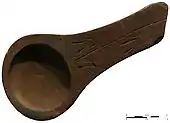Sandstone
Sandstone is a clastic sedimentary rock composed mainly of sand-sized (0.0625 to 2 mm) silicate grains. Sandstones make up about 20 to 25 percent of all sedimentary rocks.[1]
| Sedimentary rock | |
 Cut slab of sandstone showing Liesegang banding | |
| Composition | |
|---|---|
| Typically quartz and feldspar; lithic fragments are also common. Other minerals may be found in particularly mature sandstone. |
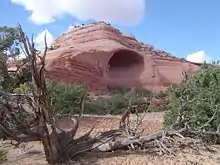
Most sandstone is composed of quartz or feldspar (both silicates) because they are the most resistant minerals to weathering processes at the Earth's surface, as seen in the Goldich dissolution series.[2] Like uncemented sand, sandstone may be any color due to impurities within the minerals, but the most common colors are tan, brown, yellow, red, grey, pink, white, and black. Since sandstone beds often form highly visible cliffs and other topographic features, certain colors of sandstone have been strongly identified with certain regions.
Rock formations that are primarily composed of sandstone usually allow the percolation of water and other fluids and are porous enough to store large quantities, making them valuable aquifers and petroleum reservoirs.[3][4]
Quartz-bearing sandstone can be changed into quartzite through metamorphism, usually related to tectonic compression within orogenic belts.[5][6]
Origins
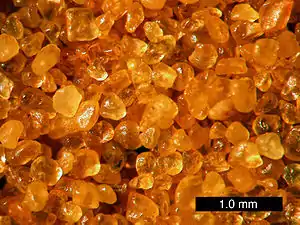
Sandstones are clastic in origin (as opposed to either organic, like chalk and coal, or chemical, like gypsum and jasper).[7] The silicate sand grains from which they form are the product of physical and chemical weathering of bedrock.[8] Weathering and erosion are most rapid in areas of high relief, such as volcanic arcs, areas of continental rifting, and orogenic belts.[9]
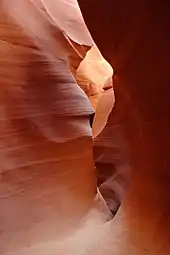
.jpg.webp)
Eroded sand is transported by rivers or by the wind from its source areas to depositional environments where tectonics has created accommodation space for sediments to accumulate. Forearc basins tend to accumulate sand rich in lithic grains and plagioclase. Intracontinental basins and grabens along continental margins are also common environments for deposition of sand.[10]
As sediments continue to accumulate in the depositional environment, older sand is buried by younger sediments, and it undergoes diagenesis. This mostly consists of compaction and lithification of the sand.[11][12] Early stages of diagenesis, described as eogenesis, take place at shallow depths (a few tens of meters) and is characterized by bioturbation and mineralogical changes in the sands, with only slight compaction.[13] The red hematite that gives red bed sandstones their color is likely formed during eogenesis.[14][15] Deeper burial is accompanied by mesogenesis, during which most of the compaction and lithification takes place.[12]
Compaction takes place as the sand comes under increasing pressure from overlying sediments. Sediment grains move into more compact arrangements, ductile grains (such as mica grains) are deformed, and pore space is reduced. In addition to this physical compaction, chemical compaction may take place via pressure solution. Points of contact between grains are under the greatest strain, and the strained mineral is more soluble than the rest of the grain. As a result, the contact points are dissolved away, allowing the grains to come into closer contact.[12]
Lithification follows closely on compaction, as increased temperatures at depth hasten deposition of cement that binds the grains together. Pressure solution contributes to cementing, as the mineral dissolved from strained contact points is redeposited in the unstrained pore spaces.[12]
Mechanical compaction takes place primarily at depths above 1,000 meters (3,300 ft). Chemical compaction continues to depths of 2,000 meters (6,600 ft), and most cementation takes place at depths of 2,000–5,000 meters (6,600–16,400 ft).[16]
Unroofing of buried sandstone is accompanied by telogenesis, the third and final stage of diagenesis.[13] As erosion reduces the depth of burial, renewed exposure to meteoric water produces additional changes to the sandstone, such as dissolution of some of the cement to produce secondary porosity.[12]
Components
Framework grains
Saunders_Quarry-1.jpg.webp)
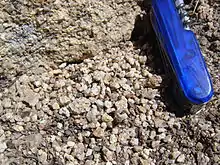
Framework grains are sand-sized (0.0625-to-2-millimetre (0.00246 to 0.07874 in) diameter) detrital fragments that make up the bulk of a sandstone.[17][18] These grains can be classified into several different categories based on their mineral composition:
- Quartz framework grains are the dominant minerals in most clastic sedimentary rocks; this is because they have exceptional physical properties, such as hardness and chemical stability.[1] These physical properties allow the quartz grains to survive multiple recycling events, while also allowing the grains to display some degree of rounding.[1] Quartz grains evolve from plutonic rock, which are felsic in origin and also from older sandstones that have been recycled.
- Feldspathic framework grains are commonly the second most abundant mineral in sandstones.[1] Feldspar can be divided into alkali feldspars and plagioclase feldspars, which can be distinguished under a petrographic microscope.[1]
- Alkali feldspar range in chemical composition from KAlSi3O8 to NaAlSi3O8.[1]
- Plagioclase feldspar range in composition from NaAlSi3O8 to CaAl2Si2O8.[1]
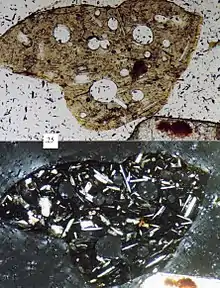
- Lithic framework grains (also called lithic fragments or lithic clasts) are pieces of ancient source rock that have yet to weather away to individual mineral grains.[1] Lithic fragments can be any fine-grained or coarse-grained igneous, metamorphic, or sedimentary rock,[1] although the most common lithic fragments found in sedimentary rocks are clasts of volcanic rocks.[1]
- Accessory minerals are all other mineral grains in a sandstone. These minerals usually make up just a small percentage of the grains in a sandstone. Common accessory minerals include micas (muscovite and biotite), olivine, pyroxene, and corundum.[1][19] Many of these accessory grains are more dense than the silicates that make up the bulk of the rock. These heavy minerals are commonly resistant to weathering and can be used as an indicator of sandstone maturity through the ZTR index.[20] Common heavy minerals include zircon, tourmaline, rutile (hence ZTR), garnet, magnetite, or other dense, resistant minerals derived from the source rock.
Matrix
Matrix is very fine material, which is present within interstitial pore space between the framework grains.[1] The nature of the matrix within the interstitial pore space results in a twofold classification:
Cement
Cement is what binds the siliciclastic framework grains together. Cement is a secondary mineral that forms after deposition and during burial of the sandstone.[1] These cementing materials may be either silicate minerals or non-silicate minerals, such as calcite.[1]
- Silica cement can consist of either quartz or opal minerals. Quartz is the most common silicate mineral that acts as cement. In sandstone where there is silica cement present, the quartz grains are attached to cement, which creates a rim around the quartz grain called overgrowth. The overgrowth retains the same crystallographic continuity of quartz framework grain that is being cemented. Opal cement is found in sandstones that are rich in volcanogenic materials, and very rarely is in other sandstones.[1]
- Calcite cement is the most common carbonate cement. Calcite cement is an assortment of smaller calcite crystals. The cement adheres to the framework grains, cementing the framework grains together.[1]
- Other minerals that act as cements include: hematite, limonite, feldspars, anhydrite, gypsum, barite, clay minerals, and zeolite minerals.[1]
Pore space
Pore space includes the open spaces within a rock or a soil.[21] The pore space in a rock has a direct relationship to the porosity and permeability of the rock. The porosity and permeability are directly influenced by the way the sand grains are packed together.[1]
- Porosity is the percentage of bulk volume that is inhabited by interstices within a given rock.[21] Porosity is directly influenced by the packing of even-sized spherical grains, rearranged from loosely packed to tightest packed in sandstones.[1]
- Permeability is the rate in which water or other fluids flow through the rock. For groundwater, work permeability may be measured in gallons per day through a one square foot cross section under a unit hydraulic gradient.[21]
Types of sandstone

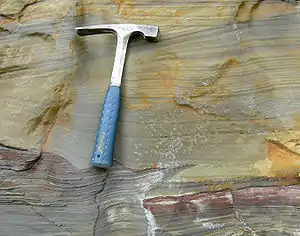
Sandstones are typically classified by point-counting a thin section using a method like the Gazzi-Dickinson Method. This yields the relative percentages of quartz, feldspar, and lithic grains and the amount of clay matrix. The composition of a sandstone can provide important information on the genesis of the sediments when used with a triangular Quartz, Feldspar, Lithic fragment (QFL diagrams). However, geologist have not been able to agree on a set of boundaries separating regions of the QFL triangle.[1]
Visual aids are diagrams that allow geologists to interpret different characteristics of a sandstone. For example, a QFL chart can be marked with a provenance model that shows the likely tectonic origin of sandstones with various compositions of framework grains. Likewise, the stage of textural maturity chart illustrates the different stages that a sandstone goes through as the degree of kinetic processing of the sediments increases.[22]
- A QFL chart is a representation of the framework grains and matrix that is present in a sandstone. This chart is similar to those used in igneous petrology. When plotted correctly, this model of analysis creates for a meaningful quantitative classification of sandstones.[23]
- A sandstone provenance chart is typically based on a QFL chart but allows geologists to visually interpret the different types of places from which sandstones can originate.
- A stage of textural maturity chart shows the differences between immature, submature, mature, and supermature sandstones. As the sandstone becomes more mature, grains become more rounded, and there is less clay in the matrix of the rock.[1]
Dott's classification scheme
Dott's (1964) sandstone classification scheme is one of many such schemes used by geologists for classifying sandstones. Dott's scheme is a modification of Gilbert's classification of silicate sandstones, and it incorporates R.L. Folk's dual textural and compositional maturity concepts into one classification system.[24] The philosophy behind combining Gilbert's and R. L. Folk's schemes is that it is better able to "portray the continuous nature of textural variation from mudstone to arenite and from stable to unstable grain composition".[24] Dott's classification scheme is based on the mineralogy of framework grains, and on the type of matrix present in between the framework grains.
In this specific classification scheme, Dott has set the boundary between arenite and wackes at 15% matrix. In addition, Dott also breaks up the different types of framework grains that can be present in a sandstone into three major categories: quartz, feldspar, and lithic grains.[1]
- Arenites are types of sandstone that have less than 15% clay matrix in between the framework grains.
- Quartz arenites are sandstones that contain more than 90% of siliceous grains. Grains can include quartz or chert rock fragments.[1] Quartz arenites are texturally mature to supermature sandstones. These pure quartz sands result from extensive weathering that occurred before and during transport. This weathering removed everything but quartz grains, the most stable mineral. They are commonly affiliated with rocks that are deposited in a stable cratonic environment, such as aeolian beaches or shelf environments.[1] Quartz arenites emanate from multiple recycling of quartz grains, generally as sedimentary source rocks and less regularly as first-cycle deposits derived from primary igneous or metamorphic rocks.[1]
- Feldspathic arenites are sandstones that contain less than 90% quartz, and more feldspar than unstable lithic fragments, and minor accessory minerals.[1] Feldspathic sandstones are commonly immature or sub-mature.[1] These sandstones occur in association with cratonic or stable shelf settings.[1] Feldspathic sandstones are derived from granitic-type, primary crystalline, rocks.[1] If the sandstone is dominantly plagioclase, then it is igneous in origin.[1]
- Lithic arenites are characterised by generally high content of unstable lithic fragments. Examples include volcanic and metamorphic clasts, though stable clasts such as chert are common in lithic arenites.[1] This type of rock contains less than 90% quartz grains and more unstable rock fragments than feldspars.[1] They are commonly immature to submature texturally.[1] They are associated with fluvial conglomerates and other fluvial deposits, or in deeper water marine conglomerates.[1] They are formed under conditions that produce large volumes of unstable material, derived from fine-grained rocks, mostly shales, volcanic rocks, and metamorphic rock.[1]
- Wackes are sandstones that contain more than 15% clay matrix between framework grains.
- Arkose sandstones are more than 25 percent feldspar.[7] The grains tend to be poorly rounded and less well sorted than those of pure quartz sandstones. These feldspar-rich sandstones come from rapidly eroding granitic and metamorphic terrains where chemical weathering is subordinate to physical weathering.
- Greywacke sandstones are a heterogeneous mixture of lithic fragments and angular grains of quartz and feldspar or grains surrounded by a fine-grained clay matrix. Much of this matrix is formed by relatively soft fragments, such as shale and some volcanic rocks, that are chemically altered and physically compacted after deep burial of the sandstone formation.
Uses

Sandstone has been used since prehistoric times for construction, decorative art works and housewares, and continues to be used. It has been widely employed around the world in constructing temples, homes, and other buildings.[25]
Although its resistance to weathering varies, sandstone is easy to work. That makes it a common building and paving material, including in asphalt concrete. However, some types that have been used in the past, such as the Collyhurst sandstone used in North West England, have had poor long-term weather resistance, necessitating repair and replacement in older buildings.[26] Because of the hardness of individual grains, uniformity of grain size and friability of their structure, some types of sandstone are excellent materials from which to make grindstones, for sharpening blades and other implements. Non-friable sandstone can be used to make grindstones for grinding grain, e.g., gritstone.
A type of pure quartz sandstone, orthoquartzite, with more of 90–95 percent of quartz,[27] has been proposed for nomination to the Global Heritage Stone Resource.[28] In some regions of Argentina, the orthoquartzite-stoned facade is one of the main features of the Mar del Plata style bungalows.[28]
See also
- Dimension stone – Natural stone that has been finished to specific sizes and shapes
- List of sandstones – Wikipedia list article
- Kurkar – Regional name for an aeolian quartz calcrete on the Levantine coast
- Sedimentary basin – Regions of long-term subsidence creating space for infilling by sediments
- Sydney sandstone
- Yorkstone – Variety of sandstone from Yorkshire, England
Notes
- Boggs, Sam (2006). Principles of sedimentology and stratigraphy (4th ed.). Upper Saddle River, N.J.: Pearson Prentice Hall. pp. 119–135. ISBN 0131547283.
- Prothero & Schwab, Donald R. & Fred (1996). Sedimentary Geology. W. H. Freeman. p. 24. ISBN 0-7167-2726-9.
- Swanson, Susan K.; Bahr, Jean M.; Bradbury, Kenneth R.; Anderson, Kristin M. (February 2006). "Evidence for preferential flow through sandstone aquifers in Southern Wisconsin". Sedimentary Geology. 184 (3–4): 331–342. Bibcode:2006SedG..184..331S. doi:10.1016/j.sedgeo.2005.11.008.
- Bjørlykke, Knut; Jahren, Jens (2010). "Sandstones and Sandstone Reservoirs". Petroleum Geoscience: 113–140. doi:10.1007/978-3-642-02332-3_4. ISBN 978-3-642-02331-6.
- Essentials of Geology, 3rd Edition, Stephen Marshak, p 182
- Powell, Darryl. "Quartzite". Mineral Information Institute. Archived from the original on 2009-03-02. Retrieved 2009-09-09.
- "A Basic Sedimentary Rock Classification", L.S. Fichter, Department of Geology/Environmental Science, James Madison University (JMU), Harrisonburg, Virginia, October 2000, JMU-sed-classif (accessed: March 2009): separates clastic, chemical & biochemical (organic).
- Leeder, M. R. (2011). Sedimentology and sedimentary basins : from turbulence to tectonics (2nd ed.). Chichester, West Sussex, UK: Wiley-Blackwell. pp. 3–28. ISBN 9781405177832.
- Blatt, Harvey; Tracy, Robert J. (1996). Petrology : igneous, sedimentary, and metamorphic (2nd ed.). New York: W.H. Freeman. pp. 241–242, 258–260. ISBN 0716724383.
- Blatt and Tracy 1996, pp. 220-227
- Blatt and Tracy 1996, pp. 265-280
- Boggs 2006, pp. 147-154
- Choquette, P.W.; Pray, L.C. (1970). "Geologic Nomenclature and Classification of Porosity in Sedimentary Carbonates". AAPG Bulletin. 54. doi:10.1306/5D25C98B-16C1-11D7-8645000102C1865D.
- Walker, Theodore R.; Waugh, Brian; Grone, Anthony J. (1 January 1978). "Diagenesis in first-cycle desert alluvium of Cenozoic age, southwestern United States and northwestern Mexico". GSA Bulletin. 89 (1): 19–32. Bibcode:1978GSAB...89...19W. doi:10.1130/0016-7606(1978)89<19:DIFDAO>2.0.CO;2.
- Boggs 2006, p. 148
- Stone, W. Naylor; Siever, Naylor (1996). "Quantifying compaction, pressure solution and quartz cementation in moderately-and deeply-buried quartzose sandstones from the Greater Green River Basin, Wyoming". Retrieved 2 October 2020. Cite journal requires
|journal=(help) - Dorrik A. V. Stow (2005). Sedimentary Rocks in the Field: A Colour Guide. Manson Publishing. ISBN 978-1-874545-69-9. Retrieved 11 May 2012.
- Francis John Pettijohn; Paul Edwin Potter; Raymond Siever (1987). Sand and Sandstone. Springer. ISBN 978-0-387-96350-1. Retrieved 11 May 2012.
- Prothero, D. (2004). Sedimentary Geology. New York, NN: W.H. Freeman and Company
- Prothero, D. R. and Schwab, F., 1996, Sedimentary Geology, p. 460, ISBN 0-7167-2726-9
- Jackson, J. (1997). Glossary of Geology. Alexandria, VA: American Geological Institute ISBN 3-540-27951-2
- Boggs 2006, pp. 130-131.
- Carozzi, A. (1993). Sedimentary petrography. Englewood Cliffs, NJ: Prentice-Hall ISBN 0-13-799438-9
- Robert H. Dott (1964). "Wacke, greywacke and matrix; what approach to immature sandstone classification?". SEPM Journal of Sedimentary Research. 34 (3): 625–32. doi:10.1306/74D71109-2B21-11D7-8648000102C1865D.
- "Sandstone: Characteristics, Uses And Problems". www.gsa.gov. Retrieved 2017-08-11.
- Edensor, T. & Drew, I. Building stone in the City of Manchester: St Ann's Church. Sci-eng.mmu.ac.uk. Retrieved on 2012-05-11.
- "Definition of orthoquartzite – mindat.org glossary". www.mindat.org. Retrieved 2015-12-13.
- Cravero, Fernanda; et al. (8 July 2014). "'Piedra Mar del Plata': An Argentine orthoquartzite worthy of being considered as a 'Global Heritage Stone Resource'" (PDF). Geological Society, London. Archived from the original (PDF) on 9 April 2015. Retrieved 3 April 2015.
Bibliography
- Folk, R.L., 1965, Petrology of sedimentary rocks PDF version. Austin: Hemphill's Bookstore. 2nd ed. 1981, ISBN 0-914696-14-9.
- Pettijohn F. J., P.E. Potter and R. Siever, 1987, Sand and sandstone, 2nd ed. Springer-Verlag. ISBN 0-387-96350-2.
- Scholle, P.A., 1978, A Color illustrated guide to constituents, textures, cements, and porosities of sandstones and associated rocks, American Association of Petroleum Geologists Memoir no. 28. ISBN 0-89181-304-7.
- Scholle, P.A., and D. Spearing, 1982, Sandstone depositional environments: clastic terrigenous sediments , American Association of Petroleum Geologists Memoir no. 31. ISBN 0-89181-307-1.
- USGS Minerals Yearbook: Stone, Dimension, Thomas P. Dolley, U.S. Dept. of the Interior, 2005 (format: PDF).
Further reading
| Wikimedia Commons has media related to Sandstone. |
- Webb, Jonathan. Sandstone shapes 'forged by gravity' (July 2014), BBC


